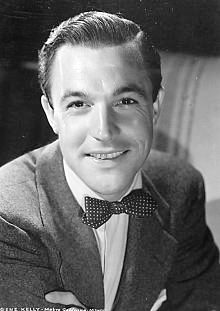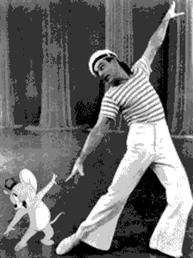| Eugene Curran "Gene" Kelly (August 23, 1912 – February 2, 1996)  |
|
Kelly was born in the Highland Park neighborhood of Pittsburgh. He was the third son of Harriet Catherine (née Curran) and James Patrick Joseph Kelly, a phonograph salesman. His father was born in Peterborough, Ontario, Canada, to a family of Irish descent. His maternal grandfather was an immigrant from Derry, Ireland, and his maternal grandmother was of German ancestry. At the age of eight, Kelly was enrolled by his mother in dance classes, along with his elder brother James. They both rebelled, and, according to Kelly: "We didn't like it much and were continually involved in fistfights with the neighborhood boys who called us sissies...I didn't dance again until I was fifteen." At one time Kelly's childhood dream was to play shortstop for the hometown Pittsburgh Pirates. Kelly returned to dance on his own initiative and by then was an accomplished sportsman and well able to take care of himself. He attended St. Raphael Elementary School in the Morningside neighborhood of Pittsburgh. He graduated from Peabody High School in 1929 at the age of sixteen. He enrolled in Pennsylvania State College to study journalism but the economic crash obliged him to seek employment to help with the family's finances. At this time, he worked up dance routines with his younger brother Fred in order to earn prize money in local talent contests, and they also performed in local nightclubs. Although he is known today for his performances in “Singin' in the Rain” and “An American in Paris”, he was a dominant force in Hollywood musical films from the mid-1940s until this art form fell out of fashion in the late 1950s. His many innovations transformed the Hollywood musical film, and he is credited with almost single-handedly making the ballet form commercially acceptable to film audiences. |
 Singin' In The Rain 1952 |
|
Kelly was the recipient of an Academy Honorary Award in 1952 for his career achievements. He later received lifetime achievement awards in the Kennedy Center Honors, and from the Screen Actors Guild and American Film Institute; in 1999, the American Film Institute also numbered him 15th in their Greatest Stars of All Time list.
In Kelly's film “Anchors Aweigh” (1945), MGM virtually gave him a free hand to devise a range of dance routines, including the celebrated animated dance with Jerry Mouse, and his duets with co-star Frank Sinatra. The iconic performance was enough for Manny Farber to completely reverse his previous assessment of Kelly's skills; reviewing the film, Farber enthused, "Kelly is the most exciting dancer to appear in Hollywood movies." Anchors Aweigh became one of the most successful films of 1945 and it garnered Kelly his first and only Academy Award nomination for Best Actor. |
 |
|
An American in Paris (1951) won six Academy Awards, including Best Picture and, in the same year, Kelly was presented with an honorary Academy Award for his contribution to film musicals and the art of choreography. The film also marked the debut of Leslie Caron, who Kelly had spotted in Paris and brought to Hollywood. Its dream ballet sequence, lasting an unprecedented seventeen minutes, was the most expensive production number ever filmed up to that point. It was described by Bosley Crowther as, "whoop-de-doo ... one of the finest ever put on the screen." Singin' in the Rain featured Kelly's celebrated and much imitated solo dance routine to the title song, along with the "Moses Supposes" routine with Donald O'Connor and the "Broadway Melody" finale with Cyd Charisse. Though the scene did not initially generate the same enthusiasm as An American in Paris, it subsequently overtook the earlier film to occupy its current pre-eminent place among critics and filmgoers alike. His first foray into television was a documentary for NBC's Omnibus, Dancing is a Man's Game (1958) where he assembled a group of America's greatest sportsmen – including Mickey Mantle, Sugar Ray Robinson and Bob Cousy – and re-interpreted their moves choreographically, as part of his lifelong quest to remove the effeminate stereotype of the art of dance, while articulating the philosophy behind his dance style. It gained an Emmy nomination for choreography and now stands as the key document explaining Kelly's approach to modern dance. In 1963 Kelly joined Universal Pictures for a two-year stint. He joined 20th Century Fox in 1965, but had little to do – partly due to his decision to decline assignments away from Los Angeles for family reasons. His perseverance finally paid off, with the major box-office hit A Guide for the Married Man (1967) where he directed Walter Matthau. Then, a major opportunity arose when Fox – buoyed by the returns from The Sound of Music (1965) – commissioned Kelly to direct Hello, Dolly! (1969), again directing Matthau along with Barbra Streisand. In the years 1970 through 1984, Kelly was an actor, director and choreographer in movies, on stage and television. Kelly's health declined steadily in the late 1980s, and a stroke in July 1994 resulted in a seven-week hospital stay. Another stroke in early 1995 left Kelly mostly bedridden in his Beverly Hills home. He died in his sleep on February 2, 1996, and his body was subsequently cremated, without any funeral or memorial services. |
|
Previous Page |
Return Home |